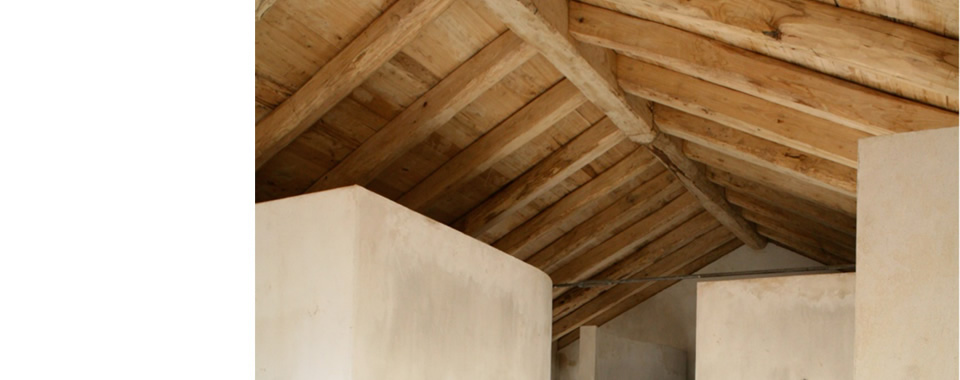

Score - Sustainable Construction in Rural and Fragile Areas for Energy efficiency
Guidelines for Integrated territorial Planning:
Solar thermal collector
The following guidelines come from a deep analysis of case studies, innovative products, norms and regulations, in relation to the local level. This analysis is summarized in a card that can be downloaded in Italian language. Solar thermal collectors convert solar energy into thermal energy, raising the temperature of heat-transport fluid for the production of hot water for sanitary use or for heating. Many systems are available on the market, with different costs and performances. Solar thermal collector can be designed for natural circulation or for forced circulation. The ones designed for natural circulation exploit convection, require the tank position to be higher compared to the collector, and have lower performances compared to the ones based on forces circulation. These work thanks to pumps functioning only when the heat-transport fluid has higher temperature compared the fluid, which is inside the tank.
The integration of solar thermal collector allows reducing the use of energy for hot water and heating of indoor spaces. Besides Mediterranean countries (and therefore Italy) have high levels of sunshine that allow better performances of these systems compared to centre of north Europe countries. Considering European Union directives, national and regional regulations are now adopting measures to favour a major diffusion of systems based on renewable resources, as it happens in Liguria wherein it is mandatory to provide to 50% of the hot water for sanitary use demand with solar thermal collector. The use of these systems allows a reduction of pollutant emissions coming from fossil sources for the production of hot water for sanitary use and for heating. On of the weakness with respect to the application of solar thermal collectors in building sector regard architectural integration difficulties. These systems are more difficult to integrate within architecture, due to the need to locate also tanks and to the higher visual impact. Conversely, the architectural integration appears more difficult in refitting works in historical context or historical buildings. With respect to this aspect, at these days both the national/regional laws and the regulations made by the local administrations seem insufficient, even if in the last few years some efforts to fix valid criteria for the integration of solar thermal collector or photovoltaic have been done.
The diffusion in the local context of solar thermal collector, considering the weakness defined, could be implemented thanks to the following actions:
- Especially in relation with retrofitting works in historical or landscape context or new constructions in historical context, the regulation form should provide precise indication but flexible, like diagrams, tables or lists of criteria to favour the integration of solar thermal collector.
- With respect to the difficulty to place tanks of solar thermal collector inside buildings, it is believed useful a major flexibility inside regulations.
- A major consideration inside regulations to aspects regarding the use of this technology also for heating indoor environments.
- Promoting the use of solar thermal collector in sector of special interest in MED countries, such as the touristic sector.
Indication for the Bio-construction Action Plan
Pursuant to the guidelines written above, are here synthetically reported the criteria/examples for pilot projects to be financed in MED territory, in relation with the specific treated theme. These criteria/examples, together with the ones resulting from all the themes of eco-construction tool matrix, will make up a Bio-construction Action Plan for each partner countries.
- Projects for a reorganization of norms and regulations, especially at local level, aimed to provide indications based on performances, precise but flexible, particularly turned to face the issues of architectural integration of solar thermal collector.
- Projects able to study and promote solutions for the architectural integration of solar thermal collector in touristic sectors (bathing resort, vacation houses, etc.), especially with the aim to investigate how to provide incentives to promote solar thermal energy demand.
- Projects aimed to favour an easier integration of solar thermal collector designed for natural, forced, or mixed circulation with respect to several aspects: tanks placing, new fastening solutions able to limit the risks for labours and consequently the safety costs; solutions able to mix other type of renewable energy (micro-generation).
Possible criteria for MED bio-housing quality certificate
Usually the certification tools provided by the main organizations don’t directly consider aspects related to the architectural integration of solar thermal collector. As it happens for LEED Italia and Itaca Protocol, the Italian version of “Green Building Challenge” (made by a network of 25 countries), which are two of the most diffused and known Italian rating systems, this technology is evaluated considering only quantitative parameters for the production of energy from renewable sources. For example, with the Itaca Protocol, solar thermal collector can be considered in the evaluation area B, category B.1 Primary energy demand during the life cycle, B.1.2 Primary energy for heating, B.1.5 Primary energy for sanitary hot water production. Also inside LEED Italia criteria for architectural integration are not mentioned; solar thermal collector can be considered inside Energy and Atmosphere (EA), credit 1 performances optimization and credit 2 Production of renewable energy in situ. This kind of evaluation, even though complex, is faced by some local regulations (see attached in PDF italian card), as the abacus for the localization of panels, in relation to the zoning (e.g. historical centre, rural areas etc.), of the “Bio-eco sustainable building regulation” of some Tuscan municipality. These are references to be considered as a possible criteria for a MED bio-housing quality certificate.
Case studies
- Reorganization of historical buildings in rural ground, farm holiday in Borzonasca (GE)
- Forestry barracks for tourism, Monte Penna (Emilia Romagna)
- New construction Passive House Dionisi, Cogoleto (GE)
- Eco refurbishment of a monastery into housing, Vaugneray, Lyon (France)
